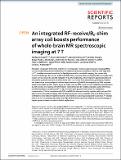An integrated RF-receive/B0-shim array coil boosts performance of whole-brain MR spectroscopic imaging at 7 T
Author(s)
Esmaeili, Morteza; Stockmann, Jason; Strasser, Bernhard; Arango, Nicolas; Thapa, Bijaya; Wang, Zhe; van der Kouwe, Andre; Dietrich, Jorg; Cahill, Daniel P; Batchelor, Tracy T; White, Jacob; Adalsteinsson, Elfar; Wald, Lawrence; Andronesi, Ovidiu C; ... Show more Show less
DownloadPublished version (12.85Mb)
Publisher with Creative Commons License
Publisher with Creative Commons License
Creative Commons Attribution
Terms of use
Metadata
Show full item recordAbstract
© 2020, The Author(s). Metabolic imaging of the human brain by in-vivo magnetic resonance spectroscopic imaging (MRSI) can non-invasively probe neurochemistry in healthy and disease conditions. MRSI at ultra-high field (≥ 7 T) provides increased sensitivity for fast high-resolution metabolic imaging, but comes with technical challenges due to non-uniform B0 field. Here, we show that an integrated RF-receive/B0-shim (AC/DC) array coil can be used to mitigate 7 T B0 inhomogeneity, which improves spectral quality and metabolite quantification over a whole-brain slab. Our results from simulations, phantoms, healthy and brain tumor human subjects indicate improvements of global B0 homogeneity by 55%, narrower spectral linewidth by 29%, higher signal-to-noise ratio by 31%, more precise metabolite quantification by 22%, and an increase by 21% of the brain volume that can be reliably analyzed. AC/DC shimming provide the highest correlation (R2 = 0.98, P = 0.001) with ground-truth values for metabolite concentration. Clinical translation of AC/DC and MRSI is demonstrated in a patient with mutant-IDH1 glioma where it enables imaging of D-2-hydroxyglutarate oncometabolite with a 2.8-fold increase in contrast-to-noise ratio at higher resolution and more brain coverage compared to previous 7 T studies. Hence, AC/DC technology may help ultra-high field MRSI become more feasible to take advantage of higher signal/contrast-to-noise in clinical applications.
Date issued
2020Department
Massachusetts Institute of Technology. Department of Electrical Engineering and Computer ScienceJournal
Scientific Reports
Publisher
Springer Science and Business Media LLC